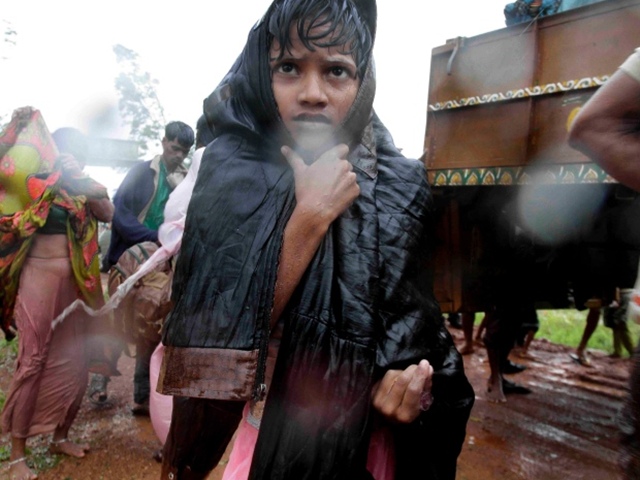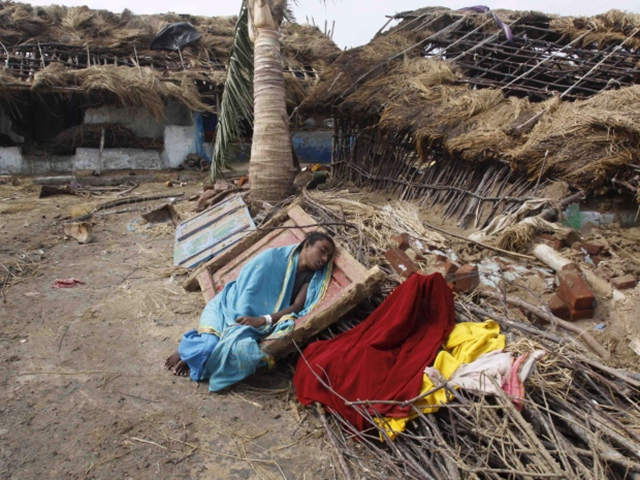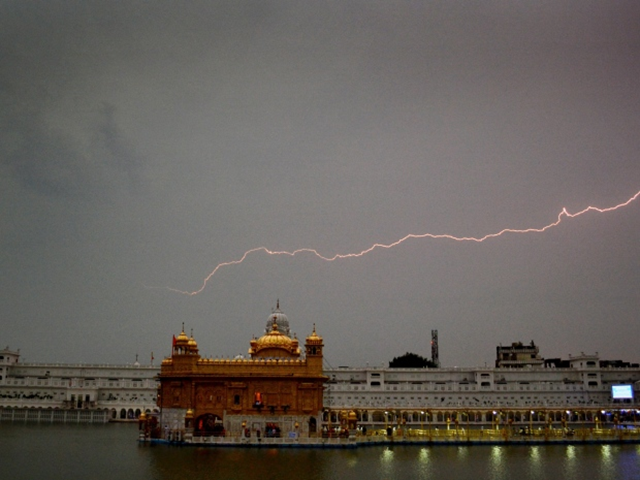Cyclone Phailin leaves widespread damage in India – Hundreds of thousands of homes washed away – ‘There are no farms left. Everything has disappeared into the water.’
13 October 2013 (AP) – People in India began sorting through the wreckage Sunday after Cyclone Phailin roared ashore, flooding towns and villages and destroying tens of thousands of thatch homes, but officials said the country had been spared the widespread loss of life that many had feared. About 18 hours after the storm — the strongest to hit India in more than a decade — made landfall in eastern Orissa state, officials said they only knew of 17 fatalities, most of them people killed by falling branches or collapsing buildings in the rains ahead of the cyclone. The final death toll will almost certainly climb, and parts of the cyclone-battered coast remain isolated by downed communication links and blocked roads. But initial indications are that the government’s evacuation of more than 900,000 people saved many lives. “Damage to property is extensive,” Amitabh Thakur, the top police officer in the Orissa district worst-hit by the cyclone. “But few lives have been lost,” he said, crediting the mass evacuations. The storm washed away tens of thousands of mud and thatched roof huts and sent seawater surging inland. It slowed significantly overnight, with some areas reporting little more than breezy drizzles by midday Sunday, but meteorologists said parts of the region would face heavy rains and winds for the next 24 hours. “Its intensity is still strong, but after crossing the coast it has weakened considerably,” Sharat Sahu, a top official with the Indian Meteorological Dept. in Orissa, told reporters.
A cargo ship carrying iron ore, the MV Bingo, sank Saturday as the cyclone barrelled through the Bay of Bengal, and its crew of 18 — including 17 Chinese and one Indonesian — went missing for a day, coast guard officials said. They were being rescued Sunday evening after their lifeboat was found about 185 kilometres off the Indian coast, coast guard Commandant Sharad Matri said. […] In Behrampur, about 10 kilometres inland from where the eye of the cyclone struck, there were no reports of deaths early Sunday morning. But the storm had wrought havoc on the small town, with the wind shattering windows, blowing down trees and electrical poles and terrifying residents. “Everyone feels very lucky,” said Prabhati Das, a 40-year-old woman from Behrampur. In the state capital of Bhubaneshwar, billboards and traffic lights had fallen across the city and trees were uprooted, but early reports indicated the state capital escaped major damage. “The 1999 storm was very big, but this was not as strong at least in Bhubaneshwar,” said Upendra Malik, a city employee leading a crew working with axes and coils of heavy rope to clear roads of fallen trees and branches. “We’ve just started to assess the damage and coastal areas will have fared worse.” Nearly 1 million people were evacuated from the coast ahead of Phailin, including more than 870,000 in Orissa and more than 100,000 in neighbouring Andhra Pradesh. [more]
India’s Cyclone Phailin leaves widespread damage 
By Sruthi Gottipati and Jatindra Dash, with additional reporting by Nita Bhalla in New Delhi; Sujoy Dhar in Kolkata; writing by Sanjeev Miglani; editing by Frank Jack Daniel and Tom Pfeiffer
13 October 2013 GANJAM/BHUBANESWAR, India (Reuters) – A mass evacuation saved thousands of lives when India’s strongest cyclone in 14 years struck, but aid workers warned on Sunday that around a million would still need help after their homes and livelihoods were destroyed. Cyclone Phailin was expected to dissipate within 36 hours, losing momentum as it headed inland after making landfall on Saturday from the Bay of Bengal, bringing winds of more than 200 kph (125 mph) that ripped apart homes and tore down trees. Authorities in the eastern state of Odisha said the death toll stood at seven people, all killed as the storm slammed in from the ocean. Six died under falling trees and one when the walls of her mud house collapsed. The relatively low number of casualties stands in contrast to the 10,000 killed by Odisha’s last big cyclone in 1999. The building of hundreds of cyclone shelters since then, along with early warnings which started five days before the storm’s arrival and orderly – often forceful – mass evacuations helped minimize loss of lives, aid officials said. At least 873,000 people in Odisha and adjacent Andhra Pradesh spent the night in shelters. Others sought safety in schools or temples, in what officials called one of India’s largest evacuations. “The loss of life has been contained this time with early information and speedy action of government,” said Sandeep Chachra, executive director of ActionAid India. […] Still, Phailin left a trail of destruction along the coast. On the highway cutting through Ganjam district in Odisha, the countryside was ravaged. An electric tower lay in a mangled metal heap on the fields. Electric poles were dislodged, power lines tangled. Inside the villages, cranes were deployed to lift trees off crushed houses. The town’s barber shop lay tilted to the side. The students’ common room in Berhampur University was a gaping hole, its facade knocked out by the cyclone. “The wind was so strong I couldn’t get out of here,” Gandhi Behera, a cook in a nearby snack shop said. Television broadcast images of cars flipped on their sides and streets strewn with debris in the silk-producing city of Brahmapur, one of the worst-hit areas. The Indian Red Cross said its initial assessments showed that over 235,000 mud-and-thatch homes owned by poor fishing and farming communities had been destroyed in Ganjam district alone. It expects thousands of people will need help in coming days. Plan International said it was concerned about the health and sanitation needs of close to a million people and the impact of the storm on people’s livelihoods. “They cannot stay in the shelters for long as they are overcrowded and sanitation issues will crop up with the spread of diseases such as diarrhea and dysentery, especially amongst young children,” said Mangla Mohanty, head of the Indian Red Cross in Odisha, said by phone from Ganjam district. Already in other parts of the state, people were making their way through destroyed farmland toward their broken homes. Dozens crammed atop mini-trucks, others trudged with sacks of belongings. Mothers held babies in their arms. “There are no farms left. Everything has disappeared into the water,” said S. Dillirao, a paddy farmer, as he stood on his inundated land. Seawater had swept into his fields. “There’s no way a single crop will grow here now,” he said. “We’ll just write a complaint. What else can I do?” [more]
Mass evacuation saves Indian lives as cyclone leaves trail of destruction


"officials said the country had been spared the widespread loss of life that many had feared."
You mean starvation is better? Becuase that's what hundreds of thousands are now facing.
With farms completely destroyed, they're just one short season for widespread famine.